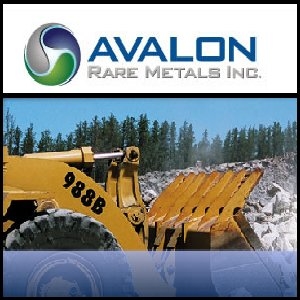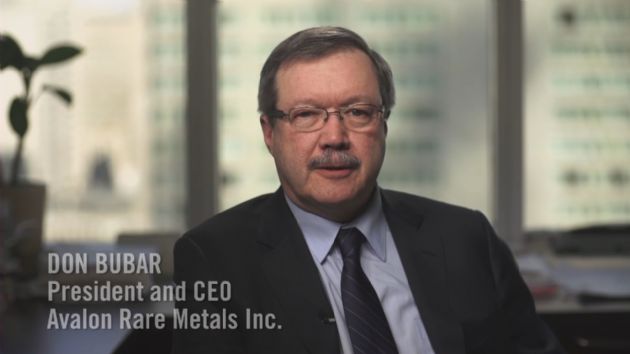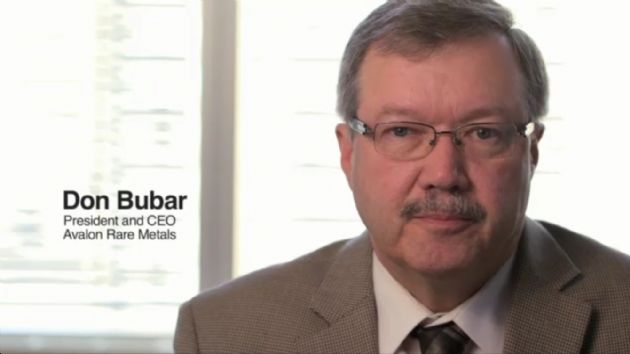 Avalon Rare Metals Inc.(TSE:AVL) Announces Remaining Assay Results from Winter Drilling on the Nechalacho REE Deposit, Thor Lake, NWT: Deposit Size Continues to Grow
Avalon Rare Metals Inc.(TSE:AVL) Announces Remaining Assay Results from Winter Drilling on the Nechalacho REE Deposit, Thor Lake, NWT: Deposit Size Continues to Grow
Toronto, July 20, 2010 AEST (ABN Newswire) - Avalon Rare Metals Inc. ( TSE:AVL) (OTCQX:AVARF) ("Avalon" or the "Company") is pleased to announce all the remaining assay results from its 2010 winter drill program on the Nechalacho rare earth elements ("REE") deposit Thor Lake, Northwest Territories, Canada. The winter drill program concluded on April 20, 2010 with 11,398 metres completed in 43 holes. Initial results from the first 22 holes were announced on May 12, 2010 and this release discloses assay results from the remaining 21 holes.
TSE:AVL) (OTCQX:AVARF) ("Avalon" or the "Company") is pleased to announce all the remaining assay results from its 2010 winter drill program on the Nechalacho rare earth elements ("REE") deposit Thor Lake, Northwest Territories, Canada. The winter drill program concluded on April 20, 2010 with 11,398 metres completed in 43 holes. Initial results from the first 22 holes were announced on May 12, 2010 and this release discloses assay results from the remaining 21 holes.
The recent results are highlighted by (1) the discovery of extensions to the high grade Basal Zone in step-out holes drilled to the north, west and south of the presently delineated Inferred Resources and (2) further high grade REE intersections in several holes drilled to define the Basal Zone in the West Long Lake area including the following exceptional intercepts:
- L10-232 with 2.07% TREO and 27.4% HREO/TREO(See Note*) over 47.45 metres,
- L10-236 with 2.50% TREO and 30% HREO/TREO over 16.55 metres,
- L10-237 with 2.16% TREO and 30% HREO/TREO over 16.75 metres,
- L10-244 with 2.16% TREO and 29% HREO/TREO over 21.1 metres and
- L10-245 with 2.35% TREO and 30% HREO/TREO over 24 metres.
2010 WINTER DRILL PROGRAM OBJECTIVES
As previously disclosed on May 12, 2010 (News Release 10-06), the winter program utilized two rigs with Rig #1 carrying out "in-fill" definition drilling to convert more of the Inferred Resources in the Basal Zone to the Indicated level of confidence, and focusing on areas that are only accessible under frozen conditions. The drill holes in this release include the west end of Long Lake ("West Long Lake") and two step out holes to the west of this area on Thor Lake (see Table 1 below).
Rig #2, which has greater depth capability, initially tested for the extension of the Basal Zone immediately south of Long Lake, then conducted condemnation drilling on proposed tailings sites (drill holes L10-231, L10-233, L10-235, L10-239 and L10-241) and finally returned to testing south of Long Lake (drill holes L10-243, L10-245 and L10-247).
All the definition drill holes were designed to reduce hole spacing in the Basal Zone to an average of 50 metres, the minimum requirement to classify the resources as Indicated. Assay results from 21 holes are reported in this release, with all but five holes (the geotechnical holes and L10-248), intersecting significant REE mineralization in the Basal Zone (see Table 2 and 3 below). A drill plan, including all drill holes completed to date, has been posted on Avalon's Thor Lake project website at:
http://www.avalonraremetals.com/projects/thor_lake/thor_lake_intro/
STEP-OUT DRILLING
On June 14, 2010 (News Release 10-08), Avalon reported that Nechalacho now ranks as the second largest REE deposit in the world by reported TREO and the third largest contained niobium deposit in the world by reported Nb2O5. Three step-out holes reported in this release, L10-243, L10-241 and L10-249, confirm extensions to the deposit to the south, north and west respectively, with all of these holes intersecting the Basal Zone beyond the boundaries of the existing Inferred and Indicated Mineral Resources and demonstrating that the deposit is still open in all three directions. This confirms the geological model where extensions to the Basal Zone mineralization under unmineralized cover rocks were predicted to occur from aeromagnetic data.
Drill hole L10-241, located on Cressy Lake (200 metres north of Thor Lake), intersected Basal Zone with 1.27% TREO and 23% HREO/TREO over 14 metres. It is believed that the Basal Zone in this area was partially "dyked-out" by a late diabase dyke and that this intercept is not necessarily representative of the Basal Zone at this location. Near vertical diabase dykes in the Nechalacho deposit are generally wide spaced, narrow in width and do not greatly affect the tonnage. As this intercept is about 390 metres northwest of the closest historic drill hole, about 570 metres northwest of the closest modern drill hole, and is not included in the Inferred Resource, the intercept is considered highly significant for expanding the deposit to the north. As well as promising REE values, the intercept included typical niobium and tantalum values for the Basal Zone. Final zirconium analyses are pending.
Testing for mineralization 100 metres south of the most southerly drill hole located on Long Lake, L10-243 intersected the Basal Zone with 1.44% TREO and 21% HREO/TREO over 18 metres. This intercept demonstrates that the south shore of Long Lake, a linear escarpment that had been previously interpreted as a fault displacing the mineralization, is simply an erosional feature and, in fact, the Basal Zone remains open to the south.
On the west end of Thor Lake, hole L10-249 intersected 1.34% TREO and 19% HREO/TREO over a long intercept of 53 metres, some 400 metres further west than any previous drill holes that intersected mineralization. The thickness of the intercept, along with the higher grade portion with 1.63% TREO over 21 metres, is particularly encouraging.
The REE mineralization at Nechalacho is magnetic and reflected by an airborne magnetic anomaly covering a large area of approximately 8 square kilometres, yet the present resource covers a smaller area of just 1.5 square kilometres, at the approximate centre of this anomaly. The recent step-out hole intercepts confirm the correlation between the airborne magnetic anomaly and subsurface REE mineralization. Significantly, less than 20% of the prospective area indicated by the magnetic anomaly has been explored to date.
DEFINITION DRILLING & CURRENT WORK
Definition drilling on the West Long Lake target area at 50 metre hole spacing has continued to intersect very high grade REE mineralization in the Basal Zone. Highlights among the drill holes in this area include L10-232 with 2.07% TREO and 27.4% HREO/TREO over 47.45 metres, L10-236 with 2.50% TREO and 30% HREO/TREO over 16.55 metres, L10-237 with 2.16% TREO and 30% HREO/TREO over 16.75 metres, L10-244 with 2.16% TREO and 29% HREO/TREO over 21.1 metres and L10-245 with 2.35% TREO and 30% HREO/TREO over 24 metres. It is anticipated that these results will increase both the tonnage and grade of the Indicated Resources in the deposit when the resource estimate is updated this summer. Results of the resource update are expected to be available by mid to late August.
The summer drill program commenced with one rig on June 28, 2010. The first drill holes are for geotechnical purposes in the areas of planned site infrastructure, following which this rig will continue definition drilling in the West Long Lake. The second rig, converted to recover very large diameter PQ core, will commence drilling around July 25, 2010.
The new airstrip was completed as of July 14, 2010, with the inaugural landing planned for July 20, 2010. Rock fill for the airstrip construction was obtained from waste rock piles left from historic mining at the T-Zone enabling further reclamation of the T-Zone site. In addition, three old abandoned trailers at the T-Zone site were moved to a location near the airstrip and refurbished to serve as additional camp space for contract work crews through the summer.
Stantec Engineering, EBA Consultants and Knight Piesold have commenced the summer program of environmental and engineering work at site. This comprises on-going baseline environmental data collection as well as field engineering studies of proposed tailings sites.
SAMPLING PROTOCOL
All drill core from the 2010 program was split on site, sampled on two metre intervals and for the first two months, shipped to the ALS Chemex facility in Vancouver, BC, and then in March-April, shipped to the ALS Chemex facility in Yellowknife, for sample preparation. For most drill holes, it is standard practice for Avalon to split the core in half, and then, in the case of Basal Zone mineralization, one half into quarters. One quarter is used for assay purposes and the second quarter is retained as a core library sample. The remaining half core is then stored for future metallurgical purposes. Core from outside the Basal Zone, including Upper Zone core, is simply halved, and half sent for assay purposes.
Analytical standards were prepared from crushed rejects of historical Lake Zone samples, then analysed at five separate laboratories to determine reproducible values. These standards were then routinely inserted into the sample batches to monitor core analyses. Barren diabase drill core is inserted as blanks. Selected duplicates are also analyzed at an alternative independent laboratory. The results reported to date were produced by ALS Chemex and achieved acceptable standard values for the main REE of economic interest (neodymium, terbium and dysprosium).
All samples are analysed at ALS Chemex in Vancouver by lithium metaborate/tetraborate fusion and dilute nitric acid digestion, followed by whole rock and 45 element multi-element ICP analysis, being ALS sample method ME-MS81. All samples contained within intercepts above the 1.6% cut-off criteria and any additional samples exceeding analytical limits or of geological significance are rerun using similar ALS method ME-MS81H for higher concentration levels. ME-MS81H is a similar method but with greater dilution in the analytical procedure. Every tenth sample has a duplicate pulp prepared which, with inserted standards and blanks, is sent to Acme Analytical in Vancouver for check analyses. Results are monitored for key elements, and in cases of QA/QC issues, re-analysis is requested.
Details of the factors used to calculate rare earth oxides are posted on www.avalonraremetals.com along with complete analytical data. Drilling operations were performed by Foraco Drilling Ltd. of Yellowknife, NWT under the supervision of J.C. Pedersen, P.Geo. Bruce Hudgins, P.Geo., maintained the geological database and monitors QA/QC on the laboratory analyses. The Company's Vice-President, Exploration, William Mercer, Ph.D., P.Geo. (Ont), P. Geol. (NWT) provided overall direction on the project. The qualified persons for the purposes of this news release are William Mercer and D.S. Bubar, P. Geo., President.
Note(*)
Total Rare Earth Oxides (TREO) refers to the elements lanthanum to lutetium, plus yttrium, expressed as oxides. See Avalon's website for conversion factors from elements to oxides. Heavy Rare Earth Oxides (HREO) refers to the elements europium to lutetium, plus yttrium, expressed as oxides as a percentage of the TREO. HREO/TREO refers to the proportion of heavy rare earth oxides as a percentage of the total rare earth oxide content of the rock.
This news release contains forward-looking information and is subject to a variety of risks and uncertainties and other factors that could cause actual events or results to differ materially from those projected in the forward-looking information. Forward-looking information is based on the opinions and estimates of management at the date the information is given, and is subject to a variety of risks and uncertainties and other factors that could cause actual events or results to differ materially from those projected in the forward-looking information. The forward-looking information contained herein is given as of the date hereof and the Company assumes no responsibility to update or revise such information to reflect new events or circumstances, except as required by law.
The tables and data can be downloaded from this link:
http://www.abnnewswire.net/media/en/docs/63338-avalon_20100719.pdf
About Avalon Advanced Materials Inc
 Avalon Advanced Materials Inc. (TSE:AVL) (OTCMKTS:AVLNF) (formerly Avalon Rare Metals) is a Canadian mineral development company specializing in niche market metals and minerals with growing demand in new technology. The Company has three advanced stage projects, all 100%-owned, providing investors with exposure to lithium, tin and indium, as well as rare earth elements, tantalum, niobium, and zirconium. Avalon is currently focusing on its Separation Rapids Lithium Project, Kenora, ON and its East Kemptville Tin-Indium Project, Yarmouth, NS. Social responsibility and environmental stewardship are corporate cornerstones.
Avalon Advanced Materials Inc. (TSE:AVL) (OTCMKTS:AVLNF) (formerly Avalon Rare Metals) is a Canadian mineral development company specializing in niche market metals and minerals with growing demand in new technology. The Company has three advanced stage projects, all 100%-owned, providing investors with exposure to lithium, tin and indium, as well as rare earth elements, tantalum, niobium, and zirconium. Avalon is currently focusing on its Separation Rapids Lithium Project, Kenora, ON and its East Kemptville Tin-Indium Project, Yarmouth, NS. Social responsibility and environmental stewardship are corporate cornerstones.




![abnnewswire.com]()
Related Companies
Social Media
Share this Article

 TSE:AVL) (OTCQX:AVARF) ("Avalon" or the "Company") is pleased to announce all the remaining assay results from its 2010 winter drill program on the Nechalacho rare earth elements ("REE") deposit Thor Lake, Northwest Territories, Canada. The winter drill program concluded on April 20, 2010 with 11,398 metres completed in 43 holes. Initial results from the first 22 holes were announced on May 12, 2010 and this release discloses assay results from the remaining 21 holes.
TSE:AVL) (OTCQX:AVARF) ("Avalon" or the "Company") is pleased to announce all the remaining assay results from its 2010 winter drill program on the Nechalacho rare earth elements ("REE") deposit Thor Lake, Northwest Territories, Canada. The winter drill program concluded on April 20, 2010 with 11,398 metres completed in 43 holes. Initial results from the first 22 holes were announced on May 12, 2010 and this release discloses assay results from the remaining 21 holes.  Avalon Advanced Materials Inc. (TSE:AVL) (OTCMKTS:AVLNF) (formerly Avalon Rare Metals) is a Canadian mineral development company specializing in niche market metals and minerals with growing demand in new technology. The Company has three advanced stage projects, all 100%-owned, providing investors with exposure to lithium, tin and indium, as well as rare earth elements, tantalum, niobium, and zirconium. Avalon is currently focusing on its Separation Rapids Lithium Project, Kenora, ON and its East Kemptville Tin-Indium Project, Yarmouth, NS. Social responsibility and environmental stewardship are corporate cornerstones.
Avalon Advanced Materials Inc. (TSE:AVL) (OTCMKTS:AVLNF) (formerly Avalon Rare Metals) is a Canadian mineral development company specializing in niche market metals and minerals with growing demand in new technology. The Company has three advanced stage projects, all 100%-owned, providing investors with exposure to lithium, tin and indium, as well as rare earth elements, tantalum, niobium, and zirconium. Avalon is currently focusing on its Separation Rapids Lithium Project, Kenora, ON and its East Kemptville Tin-Indium Project, Yarmouth, NS. Social responsibility and environmental stewardship are corporate cornerstones.






